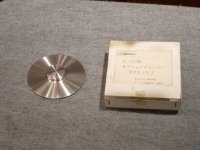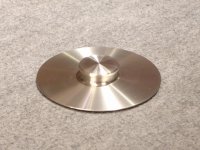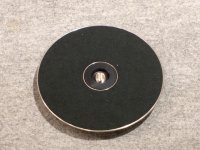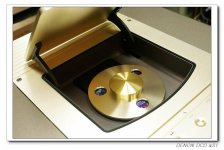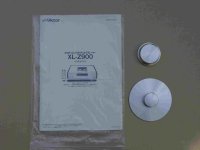anatech said:Hi Gaetan,
So are Ford cars. This has nothing to do with quality, it's a fad. Big $$ for a simple job.
Not so sure about that. I've seen reclocking on professional digital video equipment designed by people who have nowt but contempt for audiophile voodoo.
I have a friend who had nothing but the most expencive stuff ... now he use his computer hard disc drive with a professional high quality Schwiss made "plug and play" analoge converter module
Hi rfbrw,
Hopefully the level of quality in the pro gear is up to a point where small things can be heard. But I have noticed that professional studios are chasing the same bugs that plague home audio. Unsubstantiated claims and tweaks are more the norm now. Earlier in time, the engineers would say "prove it" or "show me".
I have also seen more poor quality stuff in use with the pro audio badge.
So, as I said, this depends on the quality of everything else and whether or not there is a problem there to begin with. If they are fixing a problem, expect a positive (but small) change. This would not apply to all makes either.
-Chris
Hopefully the level of quality in the pro gear is up to a point where small things can be heard. But I have noticed that professional studios are chasing the same bugs that plague home audio. Unsubstantiated claims and tweaks are more the norm now. Earlier in time, the engineers would say "prove it" or "show me".
I have also seen more poor quality stuff in use with the pro audio badge.
So, as I said, this depends on the quality of everything else and whether or not there is a problem there to begin with. If they are fixing a problem, expect a positive (but small) change. This would not apply to all makes either.
-Chris
Going way back in time:
What about the linear motors which drive the laser assembly with a coil?
Can they wear out?
All the best,
Salar
What about the linear motors which drive the laser assembly with a coil?
Can they wear out?
All the best,
Salar
Hi Hyldal,
An easy answer to that.
The one that has the least digital errors. You can look at the eye pattern and the one with the most stable eye pattern with the cleanest traces is the best drive. The information coming off a CD is an analog rf signal. No ifs, ands or buts.-Chris
Because the compact disc is designed partly quite different (thickness, inner hole diameter, internal damping of material) is this statement in my opinion not the last word
A long thead I must read, but unfortunately not many helpful informations I have found.
Here a small collection of four transport mechanism, I have heard about:
1) JVC EXU-901A with Optical Pick Up JVC OPT4 (Optima 4) used in
http://www.xs4all.nl/~hansvt/pdf/brochures/KPS25s.pdf
GT-CD1 YAMAHA HiFi-Do McIntosh/JBL/audio-technica/Jeff Rowland/Accuphase
VICTOR CDƒvƒŒƒCƒ„�[XL-Z900‚ÌŽd—l ƒrƒNƒ^�[
http://www.phase-tech.com/pdf/CT-1_catalog1.pdf
http://www.phase-tech.com/html_japan/productspage_ct-1.html
http://www.combak.net/pdf/CDP-777Test.pdf
http://www.audioenz.co.nz/2005/images/remiyo_777.jpg
Reimyo cdp-777 image by crystalref on Photobucket
in this case I have start this thread:
http://www.diyaudio.com/forums/digi...ch-ct-1-ct1-better-than-vam1254-cdpro2lf.html
2) VAU1254/VAM1254/CD12pro2-LF include PCM decoder board
DAISy : CD-Pro2 module VAU1254 (CD)
http://www.vendoramusements.com/images/DataSheet.pdf
used in a very wide range of commercial and diy cd player models, e. g.
Ancient Audio - Lektor Grand
CD-Player kits with CD-Pro2LF
NOS CD Player or
Vamp NOS CD Player :: AboutHIFI
3) CDM3 (old stuff, but still available in good condition) e. g. used in Luxman
‚c-‚T‚O‚O‚w�f‚r and Krell MD-10
http://blog.roodo.com/springnet26/2e9c9602.jpg
Krell md-10 image by jensonav on Photobucket
4) Sanyo SFP-101N mechanism include CECs belt drive peripherie, mentioned about post #8
Audio Spare SFP101N15 (SFP 101N 15) - DA11 MECHANISM 15PIN... e. g. used in
CEC CD TRANSPORT TL0X
maybe a very good template for a diy project, because the mechanism still available by a wide range of suppliers
A similar version of such Sanyo mechanism I have found in sakura systems "Flat Fish" 4713, for a review go to
47labsflatfish
Last edited:
I would rather say, any mechanism, which focuses quick and accurate, through scratches and fingerprints, with no vibration from the spindle motor will do the job. Imagine somebody would slow down a 50x speed cd-rom drive to 1x speed, this should give a very clean eye pattern... The read out data is stored in a RAM anyway and can be synced from there, no need for heavy, phonograph-heavy disc-tables...
I would rather say, any mechanism, which focuses quick and accurate, through scratches and fingerprints, with no vibration from the spindle motor will do the job. Imagine somebody would slow down a 50x speed cd-rom drive to 1x speed, this should give a very clean eye pattern... The read out data is stored in a RAM anyway and can be synced from there, no need for heavy, phonograph-heavy disc-tables...
OK. And what about the life time?
The life time of CDM1-MK-II or a CDM-3 is much more longer, and if the laser diode must replace, this isn't also no problem.
But nobody makes service by consumer use CD-rom drives for computer (e. g. replace of the optical pick up or disc motor), and therefore the life time from currently models must not be longer than maximal three years.
But may be there are also CD/DVD ROM drive mechanism for professional use and much more realibility and life time (maybe still PLEXTOR or YAMAHA ??).
If my estimate are right, such currently models I would like to know.
Last edited:
Hi Hyldal,
An easy answer to that.
The one that has the least digital errors. You can look at the eye pattern and the one with the most stable eye pattern with the cleanest traces is the best drive. The information coming off a CD is an analog rf signal. No ifs, ands or buts. -Chris
If the answer so easy, as you say, why uses some few ultimate cd mechanism heavy wights for stabilizing the compact disc while playing (CEC, Denon, Victor)? Other claims (mainly computer acessory brands), there are cleanest traces and stable eye pattern without this
Attachments
Last edited:
there used to be (maybe still is) an australian equipment manufacturer that made cd players based on computer cdrom drives
i can't recall the name right now, but it had sometime to do with trees ...
redwood or redgum or something like that ???
supposedly, when the laser expires (or some other disc playback problem), the faulty drive can be easily replaced by any compatible IDE cdrom drive, installed by the end user.
mlloyd1
i can't recall the name right now, but it had sometime to do with trees ...
redwood or redgum or something like that ???
supposedly, when the laser expires (or some other disc playback problem), the faulty drive can be easily replaced by any compatible IDE cdrom drive, installed by the end user.
mlloyd1
OK. And what about the life time?
The life time of CDM1-MK-II or a CDM-3 is much more longer, and if the laser diode must replace, this isn't also no problem.
But nobody makes service by consumer use CD-rom drives for computer (e. g. replace of the optical pick up or disc motor), and therefore the life time from currently models must not be longer than maximal three years.
But may be there are also CD/DVD ROM drive mechanism for professional use and much more realibility and life time (maybe still PLEXTOR or YAMAHA ??).
If my estimate are right, such currently models I would like to know.
Last edited:
there used to be (maybe still is) an australian equipment manufacturer that made cd players based on computer cdrom drives
i can't recall the name right now, but it had sometime to do with trees ...
redwood or redgum or something like that ???
supposedly, when the laser expires (or some other disc playback problem), the faulty drive can be easily replaced by any compatible IDE cdrom drive, installed by the end user. mlloyd1
It must be this brand:
SoundStage! Equipment Review - Redgum Audio RGCD5 CD Player (2/2001)
Product Review
REDGUM Audio Australia
http://www.eyphonyum.de/pdf/REDGUM_RGCD2.pdf
Redgum RGCD5enr v Cyrus CD8 SE?
I have heard, that there is no longer any justification for the cd mechanism mentioned by post #166, both for commercial products and for diy, because the highest possible sound quality is naturaly limited.
For highest possible sound quality and lowest possible losses the royal way should be to store the music material to a hard disc before listen.
There must be in the meantime a wide range of commercial HDD player and such for diy. Examples are to see about
Naim Audio - British manufacturer of high-fidelity audio electronics
Linn - Majik DS-I
Who can post an overview of the best threads here on diyaudio in this case?
For highest possible sound quality and lowest possible losses the royal way should be to store the music material to a hard disc before listen.
There must be in the meantime a wide range of commercial HDD player and such for diy. Examples are to see about
Naim Audio - British manufacturer of high-fidelity audio electronics
Linn - Majik DS-I
Who can post an overview of the best threads here on diyaudio in this case?
Hi tiefbassuebertr,
I'm sorry, but it seems that you aren't really clear on how a CD mechanism works. Yet, you feel the need to challenge posts made by people who do actually know what is going on. So, looking at this last statement ....
If you don't own CDs yourself tiefbassuebertr, I can understand your viewpoint. But you can't ignore the investment that the rest of us has made. We paid for the rights to enjoy musical performances (or a book being read, or instructional messages). That alone is reason enough to continue with this media. Besides, as long as you have a good CD player and sound system, the limit of the sound quality is still much higher than cassette tapes or 78s. Probably higher than many 45 rpm records as well.
-Chris
I'm sorry, but it seems that you aren't really clear on how a CD mechanism works. Yet, you feel the need to challenge posts made by people who do actually know what is going on. So, looking at this last statement ....
You know, that's all well and fine to say. It may be true that replay off a hard drive is less problematic. In fact, I'll agree with you. But you left one extremely important thing out from your statement. Just how would you expect the population to get the information off the CD and onto the hard drive? You're back to the central question at the beginning of this thread without advancing anything.For highest possible sound quality and lowest possible losses the royal way should be to store the music material to a hard disc before listen.
I'm sorry, but I am now really lost. A CD mechanism is merely a machine that retrieves the information off of media that many of us has paid for. To eliminate that ability to retrieve data that we paid for is to take away a large investment. We own the software, and it would be foolish to make it useless to us.I have heard, that there is no longer any justification for the cd mechanism mentioned by post #166, both for commercial products and for diy, because the highest possible sound quality is naturaly limited.
If you don't own CDs yourself tiefbassuebertr, I can understand your viewpoint. But you can't ignore the investment that the rest of us has made. We paid for the rights to enjoy musical performances (or a book being read, or instructional messages). That alone is reason enough to continue with this media. Besides, as long as you have a good CD player and sound system, the limit of the sound quality is still much higher than cassette tapes or 78s. Probably higher than many 45 rpm records as well.
-Chris
Hi mlloyd1,
Cyrus took another path. They designed a new transport from the ground up and has been making it available as an OEM type product. The only other alternative is Sony. Not a bad direction, but I suspect that Sony has priced themselves near the top of what the market will bear. They have a long history of doing just that, which explains why you see so many (cheap) Philips transports used.
Back when the second and third generation CD mechanisms were on the market, the Philips concept could be seen. Expensive transport that was too difficult to service properly. The radial arm, single beam system is not one that lends itself to service. Adjusting these was more difficult (to do properly) than a comparable three beam, linear tracking system. Radial tracking re-introduces all the angular issues of turntables that the CD was supposed to get away from. Way to go .... guys! Let's step backwards, why don't we? So why were linear tracking turntables invented? Both systems are tracking a spiral containing the information we want to extract.
-Chris
An English brand that did this is Creek. Is that close enough to trees? 🙂 "A creek runs by it" Sorry.there used to be (maybe still is) an australian equipment manufacturer that made cd players based on computer cdrom drives
i can't recall the name right now, but it had sometime to do with trees ...
Yes, that is the idea behind that. Understand that many manufacturers are trying to get away from the entire Philips soap opera. Service issues created by the Philips company are extremely painful to every company that used the Philips transport. All so unnecessary.supposedly, when the laser expires (or some other disc playback problem), the faulty drive can be easily replaced by any compatible IDE cdrom drive, installed by the end user.
Cyrus took another path. They designed a new transport from the ground up and has been making it available as an OEM type product. The only other alternative is Sony. Not a bad direction, but I suspect that Sony has priced themselves near the top of what the market will bear. They have a long history of doing just that, which explains why you see so many (cheap) Philips transports used.
Back when the second and third generation CD mechanisms were on the market, the Philips concept could be seen. Expensive transport that was too difficult to service properly. The radial arm, single beam system is not one that lends itself to service. Adjusting these was more difficult (to do properly) than a comparable three beam, linear tracking system. Radial tracking re-introduces all the angular issues of turntables that the CD was supposed to get away from. Way to go .... guys! Let's step backwards, why don't we? So why were linear tracking turntables invented? Both systems are tracking a spiral containing the information we want to extract.
-Chris
Hi Salar,
I'm sorry about missing your question. It is an excellent question in fact.
Firstly, it is important to understand that the laser diode is not the most common failure in a CD player. It is, however, the most expensive part normally. Therefore most less well informed repair people (they are not professionals) will condemn the head without knowing whether it is defective. The most common failure is the disc, or spindle motor. The top bearings can wear out, which causes vibration and a poor eye pattern (tons of jitter folks!). The next most common failure occurs in the bushings that the head rides on, or the rods or guides on the mechanism. Bushing wear will normally cause the head to get stuck, then release and skip forward. A bad feed motor can cause similar problems. Okay, so far we have two types of motors, bushings and still no laser failure. Hmmm. Many heads are replaced or machines discarded due to ignorance.
If a head degrades, you can be sure that the disc motor is also worn out. All other aspects of the head positioning systems may also have excessive wear.
There is one aspect of a linear motor tracking system that is additional over a normal linear tracking CD player. They normally use a linear resistance element with a sliding contact on the sled holding the head and linear motor coils. The element can physically wear out (because someone "cleaned" it, removing the protective grease), or the "fingers" on the moving contact can wear through. Oxides forming will cause predictable problems also. However, this transport type eliminates most of the wear points in a gear drive system. It's also much faster to locate new tracks.
The linear transports (non-Philips) are so reliable that I don't worry about maintenance issues. The linear tracking type is faster and less noisy, so I like those.
I hope that addresses your questions Salar. Please let me know.
-Chris
I'm sorry about missing your question. It is an excellent question in fact.
The linear mechanisms do have a wear mechanism, but I love those transports. They are fast and eliminate many contact wear points. The Sony KSS-151A would be the most common head, or the excellent Technics head and transport.Going way back in time:
What about the linear motors which drive the laser assembly with a coil?
Can they wear out?
Firstly, it is important to understand that the laser diode is not the most common failure in a CD player. It is, however, the most expensive part normally. Therefore most less well informed repair people (they are not professionals) will condemn the head without knowing whether it is defective. The most common failure is the disc, or spindle motor. The top bearings can wear out, which causes vibration and a poor eye pattern (tons of jitter folks!). The next most common failure occurs in the bushings that the head rides on, or the rods or guides on the mechanism. Bushing wear will normally cause the head to get stuck, then release and skip forward. A bad feed motor can cause similar problems. Okay, so far we have two types of motors, bushings and still no laser failure. Hmmm. Many heads are replaced or machines discarded due to ignorance.
If a head degrades, you can be sure that the disc motor is also worn out. All other aspects of the head positioning systems may also have excessive wear.
There is one aspect of a linear motor tracking system that is additional over a normal linear tracking CD player. They normally use a linear resistance element with a sliding contact on the sled holding the head and linear motor coils. The element can physically wear out (because someone "cleaned" it, removing the protective grease), or the "fingers" on the moving contact can wear through. Oxides forming will cause predictable problems also. However, this transport type eliminates most of the wear points in a gear drive system. It's also much faster to locate new tracks.
The linear transports (non-Philips) are so reliable that I don't worry about maintenance issues. The linear tracking type is faster and less noisy, so I like those.
I hope that addresses your questions Salar. Please let me know.
-Chris
Hi all: I am no expert on CD transports but I believe that very good ones are desirable to own. I have a question about the fairly new TASCAM CD-200 CD player. They claim that it's newly designed transport to be most excellent. This model CD-5020A transport was specially designed by TEAC. Does anyone have any experience with this new transport ? How does this new transport stack up against some of the better vintage units. The TASCAM CD-200 is not an extremely expensive machine and TEAC obviously knows a thing or two about excellent transport design.
I just bought one. I will let you know as the rest of my system is extremely revealing, Cheers!
I just bought one. I will let you know as the rest of my system is extremely revealing, Cheers!
That's cool John. I have been wondering about the TASCOM CD-200 with the TEAC designed CD-05020A transport for a couple of years now. I wouldn't expect the DAC/analog output stage to be top notch but the transport just might be wonderful. There isn't much information about this model across the internet. Either people aren't buying them or people aren't breaking them. There is a fairly big demand for high quality CD transports to attach high quality DACs to and the TASCAM CD-200 just might be flying under everyone's radar.
I bought it on the strength of Teacs reputation in the CD drive arena. If this is their latest iteration, it should be topnotch. I will be feeding the Anedio Dac whic IMHO opinion is the sleeper of the year. An absolutely SOTA dac for a little over a grand. I will keep everyone posted. I also have Little Dot and a HIFIDIY cdmpro2 transports. It will be interesting. I may replace the RCA with a BNC.
- Home
- Source & Line
- Digital Source
- Best CD drive mechanism
